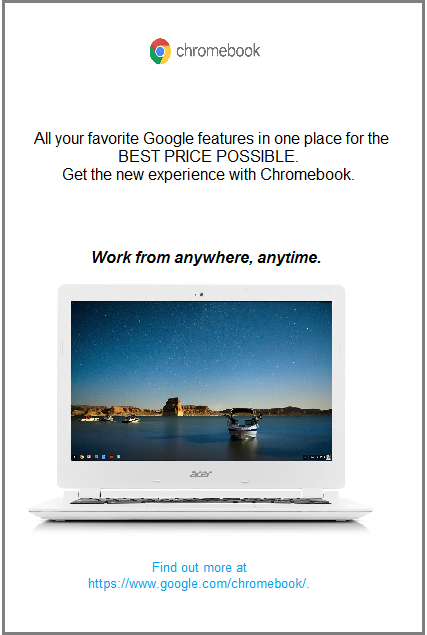Studies show that traditional advertising can be a benefit in reaching potential and returning customers who believe traditional media to be “more effective with higher mean scores as compared to online advertising” (Chao et al, p. 20). Moreover, statistics prove that a large portion of the audience still has more trust in traditional media than in online resources.
It would be more expensive, in terms of advertising cost, for Google to promote the Chromebook through traditional media. However, this is a chance to embrace a larger audience. The main media sources for advertising would most likely be television and print magazines. Chromebooks have several advantages over other computers in the market, along with strong sides, which include:
- long battery life:
- built-in security system;
- ability to synchronize with Android devices and one or more Google accounts;
- use of Google applications when working offline.
These are the product’s key features, which should be used as a basis for the advertising campaign. Besides, the target customer group includes first-time computer users and people who wish to buy additional computers. The message for this group should be based on the low price and the user-friendly interface of the Chromebook.
Print magazines usually provide one or two pages for an advertiser’s use. Thus, the text must be short yet informative. Below are two versions of possible advertisements for the Chromebook campaign.
Version 1

The text of this advertisement focuses mainly on the aspect of price. This message should appeal to people who wish to buy a second household computer, one of the target customer groups because in their case price may be a primary decision-making feature. This advertisement is meant to lay stress upon the non-visual features of Chromebooks, so the primary focus should be on the message. The colors are clean and calm, and the lines are concise. The provided URL allows readers to get more information on the product themselves.
Version 2
The same types of magazines can post articles containing so-called natural advertising. It may come in the form of an informative article sponsored by a company. For example, a magazine can publish the article “Ten things we love about computers,” with a paragraph that covers the Chromebook’s user-friendly interface.
Computers can help with lots of tasks! There are many applications, allowing you to communicate, work, and have fun. However, some users get confused when they are first introduced to all these programs. Google has solved the problem by releasing Chromebook , which has a clean interface and easy navigation. If you are buying your first computer, this might be the perfect choice for you.
Similar paragraphs may cover the rest of the Chromebook’s features. Natural advertising is good because it allows potential customers to look through the material instead of skipping over pages with product offers. However, the effect of such advertising is hard to calculate, since companies do not receive feedback on whether a product has been purchased as a result of this promotion or not.
Other potential traditional media for Chromebook advertising may include television. The short video on the computer’s website (“A New Type of Computer for Everything You Like to Do” para. 1) would make an excellent television commercial because it has different audiences presented in it, which allows customers to relate themselves to these people. The fact that the video does not tell about the Chromebook’s characteristics is beneficial, in that the commercial should not overwhelm potential customers with information.
Works Cited
“A new type of computer for everything you love to do.” Google Chromebooks. Google, 2016. Web.
Chao, Chiang-nan, Cannan Corus and Tiger Li. “Balancing traditional media and online advertising strategy.” International Journal of Business, Marketing, and Decision Sciences. 5.1 (2012): 12-24. Print.